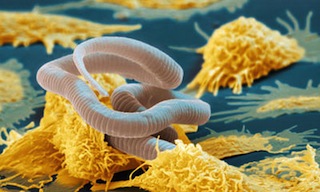Microbewiki:Lymphatic Filariasis: Difference between revisions
No edit summary |
No edit summary |
||
| Line 1: | Line 1: | ||
{{Curated}} | {{Curated}} | ||
[[Image:elephantiasis_worm.jpeg|thumb|400px|right|''Adult Wuchereria bandicrofti | [[Image:elephantiasis_worm.jpeg|thumb|400px|right|''Adult Wuchereria bandicrofti. From: http://flipside.theiet.org/ [http://flipside.theiet.org/weird/48/elephantiasis-worm.cfm]] | ||
==Description== | ==Description== | ||
Elephantiasis (also called Lymphatic Filariasis) is a disease caused by parasitic thread-like roundworms. Worldwide, most cases of Elephantiasis are caused by Wuchereria bandcrofti. However, in Asia the disease is also caused by Brugia malayi and B. timori. The parasitic worms only live in the body’s lymphatic system. The lymphatic system is a network of tubes throughout the body that is responsible for draining fluids out of the tissues. The lymphatic system also helps protect the body from infection and disease. Once in the lymphatic system, the parasites can live for 5-7 years, reproducing and increasing the severity of the disease. Worldwide, Lymphatic Filariasis is the number one cause of permanent disability. | Elephantiasis (also called Lymphatic Filariasis) is a disease caused by parasitic thread-like roundworms. Worldwide, most cases of Elephantiasis are caused by Wuchereria bandcrofti. However, in Asia the disease is also caused by Brugia malayi and B. timori. The parasitic worms only live in the body’s lymphatic system. The lymphatic system is a network of tubes throughout the body that is responsible for draining fluids out of the tissues. The lymphatic system also helps protect the body from infection and disease. Once in the lymphatic system, the parasites can live for 5-7 years, reproducing and increasing the severity of the disease. Worldwide, Lymphatic Filariasis is the number one cause of permanent disability. | ||
Revision as of 13:48, 22 July 2013

Description
Elephantiasis (also called Lymphatic Filariasis) is a disease caused by parasitic thread-like roundworms. Worldwide, most cases of Elephantiasis are caused by Wuchereria bandcrofti. However, in Asia the disease is also caused by Brugia malayi and B. timori. The parasitic worms only live in the body’s lymphatic system. The lymphatic system is a network of tubes throughout the body that is responsible for draining fluids out of the tissues. The lymphatic system also helps protect the body from infection and disease. Once in the lymphatic system, the parasites can live for 5-7 years, reproducing and increasing the severity of the disease. Worldwide, Lymphatic Filariasis is the number one cause of permanent disability.
Epidemiology
Lymphatic Filariasis affects approximately 120 million people in 73 countries worldwide. It is commonly found in tropical and sub-tropical environments, such as parts of Asia, Africa, and Western Pacific regions. It has also been documented in parts of the Caribbean and South America, but is much less common. It is most prolific in Africa and the Southern Asian countries. Because it takes hundreds of bites from infected mosquitos, short-term tourists are not at risk of Elephantiasis.
Transmission
A Lymphatic Filariasis infection spreads from one person to another through mosquito bites. The adult worms live within human lymphatic vessels. Here, they reproduce and generate millions of microscopic offsprings known as microfilariae. These microfilariae go on to circulate through the host’s blood stream. Their circulation through the blood is what allows mosquitos to pass the disease from one host to another. When the mosquito feeds on the host’s blood they take up the microfilariae, who will now grow and develop within the mosquito. Once reaching the infective stage larvae (1-3 weeks) within the mosquito, the parasites will be deposited into a new host upon the mosquito’s next feed. Once entering the new host’s blood stream, the parasites make their way to the host’s lymphatic system. Upon reaching the lymph nodes and lymphatic vessels, the parasites continue their development into adult worms. The adult parasitic worms range from 3 to 4 inches in size. The maturation process from infective stage larvae to adult worm takes approximately six months.
Pathogenesis
Clinical features
Diagnosis
Treatment
Prevention
References
1 Conway, Tyrrell. “Genus conway”. “Microbe Wiki” 2013. Volume 1. p. 1-2.
Created by {Kyle TrInidad}, students of Tyrrell Conway at the University of Oklahoma.
